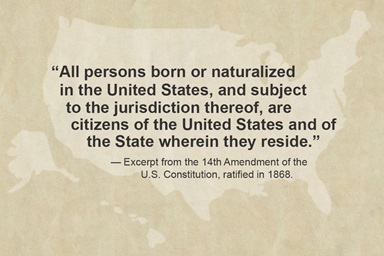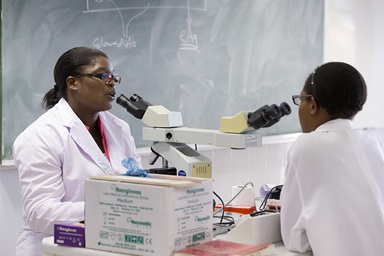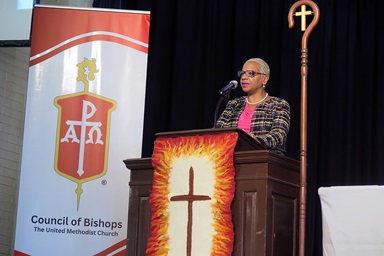United Methodists often say that rural congregations form the backbone of their denomination. For more than 50 years, the Hinton Rural Life Center in Hayesville, N.C., has been strengthening that backbone.
Think of the center as The United Methodist Church's chiropractor.
With the denomination-wide emphasis on vital congregations, the Hinton Center now plays a key role in cultivating vital, small, country churches across the United States.
"Where there is vitality in the rural church, there is vigor and strength and life in ministry among people," said the Rev. Amy Spivey, Hinton's director of program ministries. "Building on the familial and relational nature of rural community, a vital church looks beyond itself, identifies tangible needs and reaches out in the name of Christ."
Since its founding by Methodists in Clay County, the retreat center has expanded beyond its initial mission as a place for rest and revival for churches in the sparsely populated, wooded mountains of western North Carolina.
Today, the mission agency provides training and resources for rural and small-membership congregations across the United States. It also offers volunteer opportunities for churchgoers to do home repairs and help build affordable housing for low-income families.
Most significantly, the ministry serves pastors and congregants who struggle with shrinking communities and shifting demographics — and too often feel support is hard to find. A 2010 survey by the United Methodist Rural Fellowship reported that many rural church leaders feel misunderstood and unappreciated by The United Methodist Church as a whole.
Not all small churches are rural nor are all rural churches small. But small-membership suburban and urban churches often share similar strengths and challenges as their rural peers.
Small churches often can bear witness to the gospel in ways larger churches can't, Spivey said.
"With a rootedness in a particular community, the small church is often deeply and uniquely connected to place and to land through history, tradition, family and kinship," she said, "and the character of the small church is shaped and formed through trusted and shared relationships."
But these churches experience problems when they see their purpose "as maintenance, as just existing to be sure the graveyard is looked after," said the Rev. Rufus Stark, a Hinton Center board member and Hayesville resident.
With a focus on Jesus Christ, Hinton helps churches move from a cemetery mindset to a resurrected ministry.
"Hinton has been able to engage churches in visioning and being able to imagine what they could be if they wanted to be, using the assets that they have," Stark said.
Setting a vision
The Rev. Clay Smith pastored small, rural churches before becoming the Hinton Center's executive director from 1984 until his retirement in 2008.
In his early years of ministry, he noticed an absence in almost all smaller-membership churches.
"They never sat down, at least once a year, and just asked the question: Where is God calling us? And, what are the things we need to be doing to get there?" he said.
Too often, he said, work around small churches instead would concentrate on what they lacked compared to larger congregations. Church members would talk about how they did not have enough money or enough children or enough people in general.
At Hinton, Smith and others have worked with church leaders to reverse this mentality of scarcity and begin working on a strategic plan to realize God's vision.
Hinton staff members start by getting church leaders to talk about what their congregation does well and how it can use its gifts and strengths to reach new people.
"Sometimes just getting people to step inside the door of the church is a challenge," Smith acknowledged.
Still, he has helped churches overcome that obstacle.
For example, he points to a church that offers a free soup and sandwich lunch each Wednesday in Lent. "They have many people from the community who come to that who don't come on Sunday morning," he said. "You know, they pick up a few (new members)."
Nurturing leaders
For the Rev. Denise Kilgo-Martin, the Hinton Center's First Parish Project is helping her form friendships and learn alongside fellow new young clergy from a variety of denominations.
The Lilly Endowment-funded program offers colleague support, leadership development and spiritual growth for clergy serving in their first appointment in a church of small membership. Groups of clergy from across the United States meet at Hinton six times over a two-year period.
Kilgo-Martin, a graduate of Duke Divinity School, is serving her first appointment as pastor of New Hope United Methodist Church in Monroe, N.C. The church, which averages about 70 people in worship, serves a congregation of mainly blue-collar working people — many older than 60. She began participating in the First Parish Project in November 2011.
At a recent First Parish Project seminar focused on the Holy Spirit "and how we need to reclaim an awareness of the power of the Holy Spirit as a key to church renewal," she said. The class encouraged participants to be more intentional about recognizing and acknowledging the presence of the Holy Spirit in meetings, in worship and in all things.
"Our FPP group has really bonded together from the get-go, and time with these dear friends is priceless for ministry," she said.
She also has learned that a vital small church does not have to "have everything" that larger churches market. But like Smith, she thinks churches need to find their calling from God.
"And to be vital they must be willing to always be growing in their faith and lives together," she said. "Our journey of faith is that, a journey, and so we are always seeking to know and love God more, and continue being transformed into faithful disciples who constantly seek the direction of the Holy Spirit."
Strengthening the connection
The Rev. Geraldine McClellan first learned of the Hinton Center in 2000, the year she became a district superintendent in the Florida Conference. Her district at that time had 84 churches, the majority of them small-membership congregations.
Looking for resources to revitalize those congregations, she went on the Internet, typed in "retreat centers for small membership churches." Hinton's site was near the top of the list.
She arranged for Hinton to lead a training session in the Gainesville, Fla., area that was open to church leaders from the entire conference.
The center's training helps small churches "feel needed," she said.
"Many times, small-membership churches feel that they're not a part of the connection, that the larger church or the middle-size church receives all of the acknowledgement," McClellan said. "And they've felt for a long time that the only thing that the church wanted from them was that small amount of apportionment money that they could pay to help carry on the annual conferences, our jurisdictional conferences and (general church) expenses. So they've felt disconnected."
Hinton helps connect churches with the resources and services that districts and conferences offer to help small congregations.
"Not only did Hinton help them to understand that," she said, "but a part of what we did within the district was to begin to help churches understand that every resource that the annual conference had was at their disposal."
She now has served on the center's board for 10 years and completed a term as chair in December 2011.
The essential ministry of small churches
Rural churches are how John Wesley's Methodist movement spread across the North American continent, and in some cases, they are the only presence keeping their communities alive.
Even now, about six in 10 of The United Methodist Church's roughly 33,000 U.S. congregations are in rural settings. That is, they are in counties with 200 or fewer people per square mile.
The denomination has even more small-membership churches. More than two-thirds — 69.8 percent — of U.S. United Methodist congregations have fewer than 200 members, according the General Council on Finance and Administration, the denomination's finance agency.
McClellan grew up and was nurtured in a small, rural congregation. At a small, country church, she said, "Everybody knows everybody. Everybody is there to help each other. &ellipsis; It's a community-based fellowship where the concerns of one family become the concerns of the whole church, where you don't feel left alone."
If such churches shuttered their doors, whole communities would lose not only a house of worship but also a place for town meetings and summer youth programs.
"Large churches frighten people sometimes," McClellan said. "The crowds are too big. And I need to be in a small setting so that I can feel the presence of God and can know that I can connect with folks and not be afraid before I step outside of this box into a bigger box. So I just hope we don't lose the feel, the need for, the small church because it prepares us for what's to come."
Stark, her fellow board member, said small churches offer a model for the way larger congregations, even mega-churches, can operate.
"I've discovered that the way that mega-churches function - the ones that are successful - break the congregations into small groups," he said. And it's the value of the small-membership groups within a large body that make a mega-church operate. &ellipsis; That's what a rural church offers."
*Hahn is a multimedia reporter for United Methodist News Service.
News media contact: Heather Hahn, Nashville, Tenn. (615) 742-5470 or mailto:newsdesk@umcom.org.
Like what you're reading? Support the ministry of UM News! Your support ensures the latest denominational news, dynamic stories and informative articles will continue to connect our global community. Make a tax-deductible donation at ResourceUMC.org/GiveUMCom.



